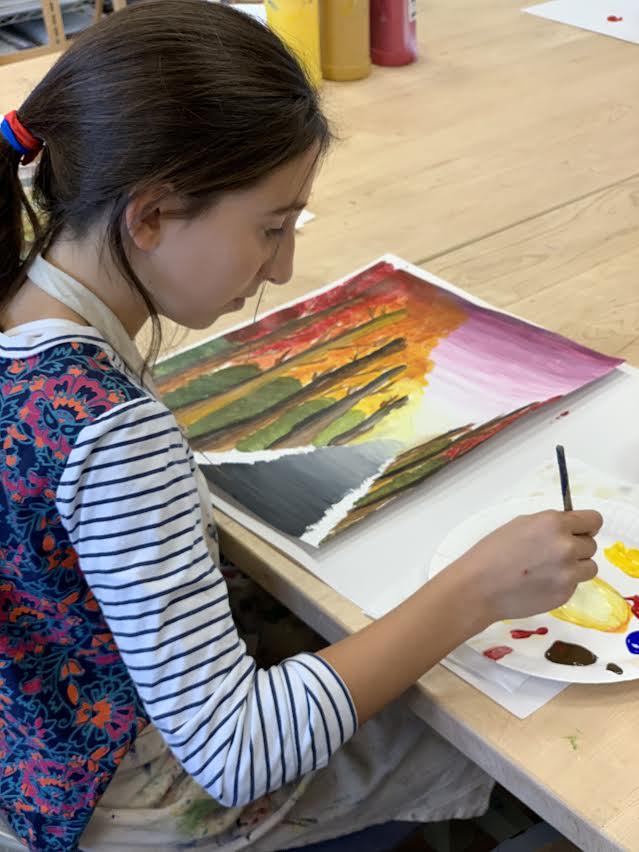OUR STUDIO

Why Choose
Canvas Studio Art
We have thoughtfully cultivated an environment for all ages that promotes observation, reflection, and practice. Our studio is a bright open space that is safe, engaging, and all things creative! Each class is infused with age appropriate lessons that explore art history, color theory, and the elements of art and principles of design.
Students at any age can expect unique opportunities to explore and gain deeper understanding of new media and processes while also expressing their own artistic voice.
Our classes are led by our knowledgeable and caring instructors whom embrace Canvas’ principles while bringing their own creative practice to our classes. Together, we strive to provide our communities’ children with a creative + welcoming place, where students are uninhibited to explore their creativity.
What we do
Our Creative Approach
Our class structure and curriculum was designed by professional artists and art educators to advance practical and conceptual methods for artists at any age. All of our teachers share Canvas’ mission to promote creative freedom, focus on visual language, and a life long love of artistic expression.
We aim to spark our students’ thoughts, interests and perception in a way that inspires and encourages each child to express their ideas visually, while offering individualized guidance during the creative process.
Regardless of your age or skill level, students come to Canvas for the warm + creative environment and the desire to explore their personal artistic direction.


Why the arts are important in your child’s growth
“Ever notice how kids often have more fun playing with an empty box than with what was inside of it? That’s their imagination at work, and as parents, we should not underestimate how vital it is to nurture this creative spirit.”
Developmental Benefits of Art
Motor Skills: Many of the motions involved in making art, such as holding a paintbrush or scribbling with a crayon, are essential to the growth of fine motor skills in young children. Many preschool programs emphasize the use of scissors because it develops the dexterity children will need for writing.
Language Development: For very young children, making art—or just talking about it—provides opportunities to learn words for colors, shapes and actions. Students can use descriptive words to discuss their own creations or to talk about what feelings are elicited when they see different styles of artwork.
Decision Making: According to a report by Americans for the Arts, art education strengthens problem-solving and critical-thinking skills. The experience of making decisions and choices in the course of creating art carries over into other parts of life. “If they are exploring and thinking and experimenting and trying new ideas, then creativity has a chance to blossom,” says MaryAnn Kohl, an arts educator and author of numerous books about children’s art education.
Visual Learning: Drawing, sculpting with clay and threading beads on a string all develop visual-spatial skills, which are more important than ever. Even toddlers know how to operate a smart phone or tablet, which means that even before they can read, kids are taking in visual information. This information consists of cues that we get from pictures or three-dimensional objects from digital media, books and television.
Art education teaches students how to interpret, criticize, and use visual information, and how to make choices based on it.”
Inventiveness: When kids are encouraged to express themselves and take risks in creating art, they develop a sense of innovation that will be important in their adult lives. “The kind of people society needs to make it move forward are thinking, inventive people who seek new ways and improvements, not people who can only follow directions,” says Kohl. “Art is a way to encourage the process and the experience of thinking and making things better!”
Cultural Awareness: As we live in an increasingly diverse society, the images of different groups in the media may also present mixed messages. Teaching children to recognize the choices an artist or designer makes in portraying a subject helps kids understand the concept that what they see may be someone’s interpretation of reality.
Improved Academic Performance: Studies show that there is a correlation between art and other achievement. A report by Americans for the Arts states that young people who participate regularly in the arts (three hours a day on three days each week through one full year) are four times more likely to be recognized for academic achievement, to participate in a math and science fair or to win an award for writing an essay or poem than children who do not participate.
Source: The Importance of Art in Child Development, PBS.org

